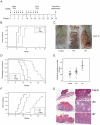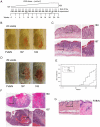E6 and E7 from beta HPV38 cooperate with ultraviolet light in the development of actinic keratosis-like lesions and squamous cell carcinoma in mice
- PMID: 21779166
- PMCID: PMC3136451
- DOI: 10.1371/journal.ppat.1002125
E6 and E7 from beta HPV38 cooperate with ultraviolet light in the development of actinic keratosis-like lesions and squamous cell carcinoma in mice
Erratum in
-
Correction: E6 and E7 from Beta Hpv38 Cooperate with Ultraviolet Light in the Development of Actinic Keratosis-Like Lesions and Squamous Cell Carcinoma in Mice.PLoS Pathog. 2016 Oct 28;12(10):e1006005. doi: 10.1371/journal.ppat.1006005. eCollection 2016 Oct. PLoS Pathog. 2016. PMID: 27792794 Free PMC article.
Abstract
Cutaneous beta human papillomavirus (HPV) types appear to be involved in the development of non-melanoma skin cancer (NMSC); however, it is not entirely clear whether they play a direct role. We have previously shown that E6 and E7 oncoproteins from the beta HPV type 38 display transforming activities in several experimental models. To evaluate the possible contribution of HPV38 in a proliferative tissue compartment during carcinogenesis, we generated a new transgenic mouse model (Tg) where HPV38 E6 and E7 are expressed in the undifferentiated basal layer of epithelia under the control of the Keratin 14 (K14) promoter. Viral oncogene expression led to increased cellular proliferation in the epidermis of the Tg animals in comparison to the wild-type littermates. Although no spontaneous formation of tumours was observed during the lifespan of the K14 HPV38 E6/E7-Tg mice, they were highly susceptible to 7,12-dimethylbenz(a)anthracene (DMBA)/12-0-tetradecanoylphorbol-13-acetate (TPA) two-stage chemical carcinogenesis. In addition, when animals were exposed to ultraviolet light (UV) irradiation, we observed that accumulation of p21(WAF1) and cell-cycle arrest were significantly alleviated in the skin of Tg mice as compared to wild-type controls. Most importantly, chronic UV irradiation of Tg mice induced the development of actinic keratosis-like lesions, which are considered in humans as precursors of squamous cell carcinomas (SCC), and subsequently of SCC in a significant proportion of the animals. In contrast, wild-type animals subjected to identical treatments did not develop any type of skin lesions. Thus, the oncoproteins E6 and E7 from beta HPV38 significantly contribute to SCC development in the skin rendering keratinocytes more susceptible to UV-induced carcinogenesis.
Conflict of interest statement
The authors have declared that no competing interests exist.
Figures






Similar articles
-
Beta HPV38 oncoproteins act with a hit-and-run mechanism in ultraviolet radiation-induced skin carcinogenesis in mice.PLoS Pathog. 2018 Jan 11;14(1):e1006783. doi: 10.1371/journal.ppat.1006783. eCollection 2018 Jan. PLoS Pathog. 2018. PMID: 29324843 Free PMC article.
-
Skin hyperproliferation and susceptibility to chemical carcinogenesis in transgenic mice expressing E6 and E7 of human papillomavirus type 38.J Virol. 2005 Dec;79(23):14899-908. doi: 10.1128/JVI.79.23.14899-14908.2005. J Virol. 2005. PMID: 16282489 Free PMC article.
-
Human papillomavirus type 38 E6 and E7 act as tumour promoters during chemically induced skin carcinogenesis.J Gen Virol. 2013 Apr;94(Pt 4):749-752. doi: 10.1099/vir.0.048991-0. Epub 2012 Dec 5. J Gen Virol. 2013. PMID: 23223623
-
The biology of beta human papillomaviruses.Virus Res. 2017 Mar 2;231:128-138. doi: 10.1016/j.virusres.2016.11.013. Epub 2016 Nov 14. Virus Res. 2017. PMID: 27856220 Review.
-
Papillomavirus-associated squamous skin cancers following transplant immunosuppression: one Notch closer to control.Cancer Treat Rev. 2014 Mar;40(2):205-14. doi: 10.1016/j.ctrv.2013.08.005. Epub 2013 Aug 22. Cancer Treat Rev. 2014. PMID: 24051018 Review.
Cited by
-
Strong association of TLR2 and TLR3 polymorphisms with keratoacanthoma and common warts: a case-control study.Croat Med J. 2024 Jun 13;65(3):232-238. doi: 10.3325/cmj.2024.65.232. Croat Med J. 2024. PMID: 38868969 Free PMC article.
-
Association of Human Papillomavirus Vaccine With the Development of Keratinocyte Carcinomas.JAMA Dermatol. 2017 Jun 1;153(6):571-574. doi: 10.1001/jamadermatol.2016.5703. JAMA Dermatol. 2017. PMID: 28196178 Free PMC article.
-
Molecular Mechanisms of Human Papillomavirus Induced Skin Carcinogenesis.Viruses. 2017 Jul 14;9(7):187. doi: 10.3390/v9070187. Viruses. 2017. PMID: 28708084 Free PMC article.
-
Viruses in Skin Cancer (VIRUSCAN): Study Design and Baseline Characteristics of a Prospective Clinic-Based Cohort Study.Cancer Epidemiol Biomarkers Prev. 2020 Jan;29(1):39-48. doi: 10.1158/1055-9965.EPI-19-0446. Epub 2019 Aug 19. Cancer Epidemiol Biomarkers Prev. 2020. PMID: 31427307 Free PMC article.
-
Contribution of Beta-HPV Infection and UV Damage to Rapid-Onset Cutaneous Squamous Cell Carcinoma during BRAF-Inhibition Therapy.Clin Cancer Res. 2015 Jun 1;21(11):2624-34. doi: 10.1158/1078-0432.CCR-14-2667. Epub 2015 Feb 27. Clin Cancer Res. 2015. PMID: 25724524 Free PMC article.
References
-
- Pisani P, Bray F, Parkin DM. Estimates of the world-wide prevalence of cancer for 25 sites in the adult population. Int J Cancer. 2002;97:72–81. - PubMed
-
- Ananthaswamy HN, Loughlin SM, Cox P, Evans RL, Ullrich SE, et al. Sunlight and skin cancer: inhibition of p53 mutations in UV-irradiated mouse skin by sunscreens. Nat Med. 1997;3:510–514. - PubMed
-
- Armstrong BK, Kricker A. The epidemiology of UV induced skin cancer. J Photochem Photobiol B. 2001;63:8–18. - PubMed
-
- Preston DS, Stern RS. Nonmelanoma cancers of the skin. N Engl J Med. 1992;327:1649–1662. - PubMed
-
- Boyle J, MacKie RM, Briggs JD, Junor BJ, Aitchison TC. Cancer, warts, and sunshine in renal transplant patients. A case-control study. Lancet. 1984;1:702–705. - PubMed
Publication types
MeSH terms
Substances
LinkOut - more resources
Full Text Sources
Medical
Molecular Biology Databases
Research Materials
Miscellaneous

